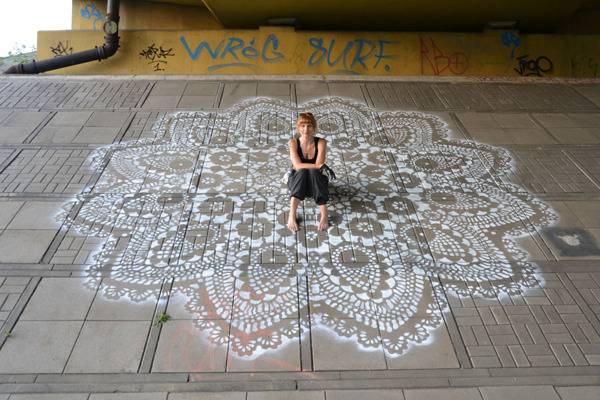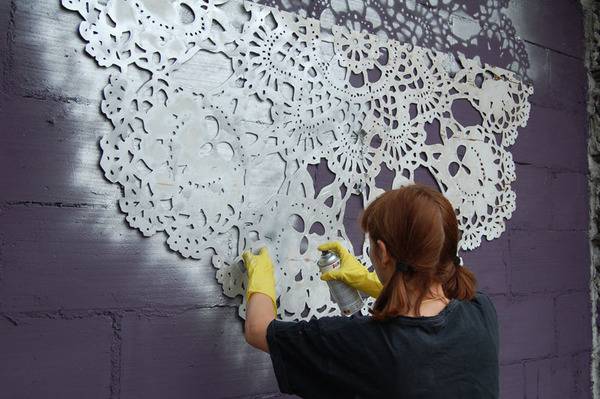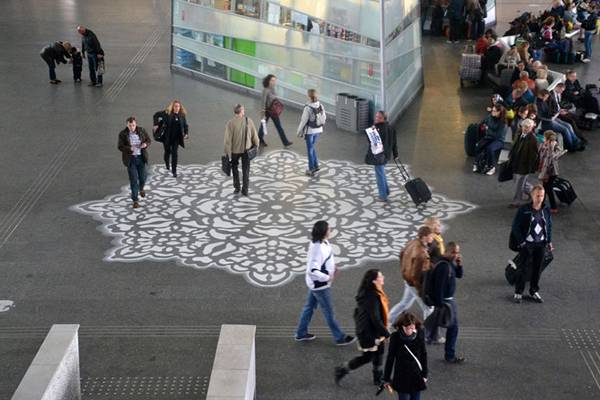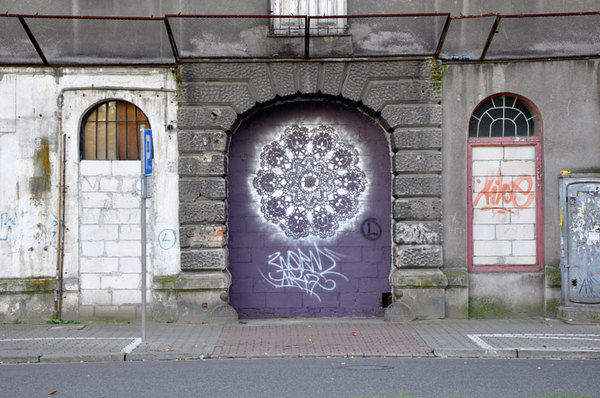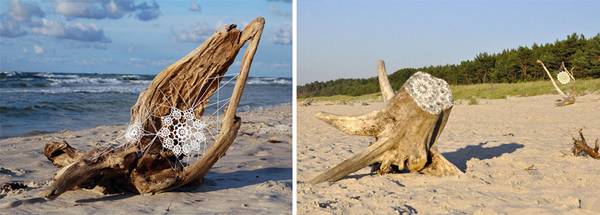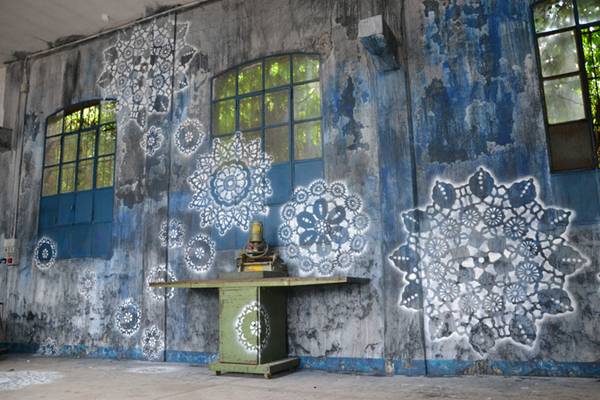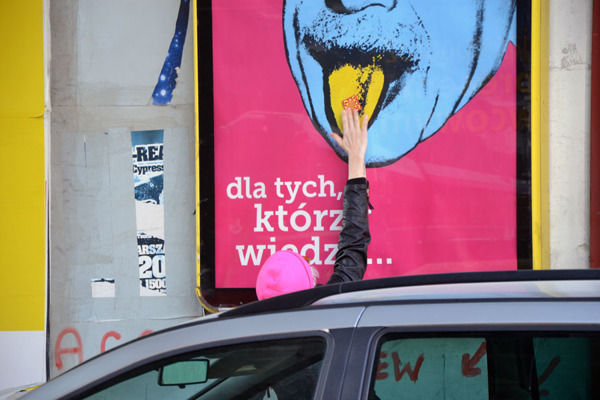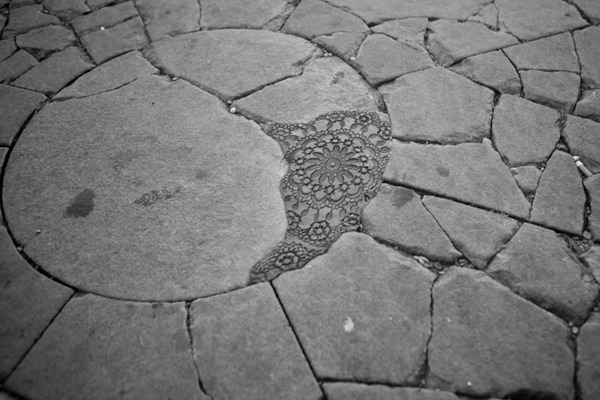Polish Street Artist NeSpoon Decorates Neglected Urban Spaces with Lace. For many, the term “street art” still has something of a seedy connotation, conjuring up images of the graffiti tagging and vandalism that occurs in many urban neighbourhoods. However, modern street artists are challenging these notions, and today street art has become an incredibly diverse and unique art form, gaining increased recognition and legitimacy from both the public and authorities. NeSpoon, a Polish street artist based in Warsaw, is one of these modern street artists who are changing the public perception of graffiti and street art. Using her artwork as a tool, NeSpoon transforms and beautifies neglected urban spaces in cities around the world.
Ranging from painting to sculpture, from ceramics to textiles, NeSpoon’s body of work is both unique and diverse. By incorporating the recurring theme of lacework patterns, her understated and delicate work hardly fits into the typical, gritty imagery people tend to associate with graffiti and street art. NeSpoon’s use of traditional techniques, materials and motifs is contrasted with its urban, frequently concrete-dominated setting, creating a memorable impression. However, despite this seeming opposition of these elements, rarely does her work feel in conflict with its setting. Being highly connected to site context, NeSpoon makes her choices about material and techniques very deliberately. Depending on the piece, her works might integrate seamlessly into their environment, or create such contrast that they become impossible to overlook. There is something fun, playful and unexpected about NeSpoon’s work. From her techniques, to her materials, to the implementation, perhaps its most defining element is this element of unexpectedness present throughout her work. Just being a woman so involved street art, typically thought to be dominated by urban male youths, defies expectations. The delicate femininity and understated nature of her art also contrasts traditional graffiti’s bright colors and bold shapes. Even the forms themselves, the softness organic and intricate forms of lace against the harsh, often imposing nature of the concrete create contrast. NeSpoon’s describes her own intent as being to beautify neglected places, referring to her own work as jewelry for public spaces. She states “jewelry makes people look pretty, my public jewelry has the same goal, make public spaces look better.” Beyond its inherent beauty, the prominent use of crochet and lace motifs throughout NeSpoon’s work is perhaps in reference to Poland’s rich history and tradition of art and craft. The art of lacemaking is an ancient craft, originating in the Middle Ages, and which remains an important part of European heritage and culture, with lace and embroidery present throughout national costumes and folk art. These motifs, when combined with the modern street art movement, create a unique style that combines elements of past and present Poland. NeSpoon’s particular focus on enhancing neglected public spaces, which are frequently plagued by tagging and other forms of vandalism, emphasizes the importance of the ways in which these spaces shape day-to-day life. Whether intentional or not, the contrast of her organic, lace-inspired art with the sterile and stagnant concrete that often dominates such places draws attention to these underused and under loved public spaces and generates discussion about the ways that they are used and maintained. There is also a political element to Nespoon’s work. In an objection to consumerist society and to the commodification of public spaces, NeSpoon has converted many advertisements and billboards in public spaces into works of art. This action calls into question the role of advertisement in public space while generating both consciousness and criticism of the rise of capitalist consumerism in Europe. Although most of NeSpoon’s work is done without permission from local authorities, many would hesitate to call her work vandalism, due to its fundamental beauty and visual appeal. This differentiation raises important questions about when street art transcends the label of vandalism, and becomes art in itself, enhancing and contributing to the quality of the public realm. As well as this, it begs the question of who owns, and thus who has the right to modify public spaces. With many appreciators around the world, both on and offline, it seems that NeSpoon has been able to achieve her goal of beautifying neglected spaces. Her work has also helped to generate discussion about the treatment of neglected spaces in cities and improving the reputation and public perception of street art. By blurring the lines between vandalism and art, NeSpoon, along with other modern street artists, are changing perceptions and notions about street art. Street art engages people in public spaces and frequently raises important questions about ownership and the role of public space in daily life, all while creating beauty in the city. Article written by Michelle Biggs Return to Homepage Published in BlogLogin
Lost Password
Register
If this is your first time on the new site, please click "Forgot your password?". Follow the steps to reset your password. It may be the same as your old one.


